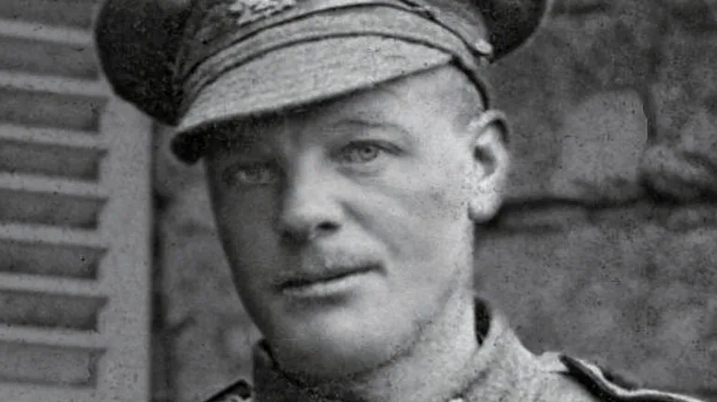Via CBC News
More than 100 years after a Canadian soldier went missing on a bloody battlefield during the First World War, his remains have been identified after being found in France.
Sgt. Richard Musgrave will now be honoured with a full military burial in France with family, following confirmation from the Department of National Defence this week.
For Musgrave's family, who never forgot the fallen soldier, the news comes as a great comfort.
Sergeant Richard Musgrave. (Department of Defence)
The discovery marks the final chapter in a long story that is marked by courage, tragedy and, finally, closure.
"I was stunned. I couldn't believe it," James Musgrave Coltman, the soldier's great-nephew, told CBC News from Scotland.
"After all this, 100 years, and suddenly it comes up again."
A one-way ticket to Calgary
Richard Musgrave was born in Blackrigg, Scotland, in 1884, and worked as a teamster when he came to Canada.
"The man that he worked for sold two horses to somebody in Canada, which I think was in Calgary … and he delivered them to the buyer," Coltman said.
"He only had a one-way ticket. When he got to Calgary, the job was done [and it was] 'Tough, you're on your own.'"
Sergeant Richard Musgrave's attestation papers. (Library and Archives Canada)
Everything Coltman knows about his ancestor came from his granny — Musgrave's sister.
Some details are vague because Musgrave did not write home very often.
But the Department of National Defence said he continued working as a teamster in Calgary before enlisting in the Canadian Forces on April 30, 1915.
Reported missing and presumed dead
After training in England, Musgrave went to France in 1916 and graduated in rank from a private to a sergeant the following year.
Though wounded in battle in April 1917, he remained on duty, and was awarded the Military Medal for bravery that July.
The following month, as a member of the 7th Infantry Battalion, he was dispatched to what would become known as the Battle of Hill 70 near Lens, France.
The Battle of Hill 70 occurred shortly after Vimy Ridge, and was a similar kind of assault, said Kent Griffiths, a retired major with the Canadian Armed Forces and curator of the Calgary Highlanders Museum and Archives at the Military Museums in Calgary.
Stretcher-bearers tend to wounded Canadian soldiers during the Battle of Hill 70, at a medical station near the front. (Library and Archives Canada)
"It was the use of a rolling barrage once again, where the artillery would fire just ahead of the assaulting troops, so that the enemy would stay in their trenches because the artillery was pounding down on them," Griffiths said.
"And the assaulting troops would just take over the high ground."
There were a lot of soldiers lost, Griffith said. The bodies of many soldiers killed in action during wartime in France were never recovered.
On Aug. 15, 1917, on the first day of the battle, Musgrave was reported missing and presumed dead. He was 32 years old.
"Though it's 100 years ago, Dick was always in our minds," James said.
There was a photo of him hung in his granny's house, he said, accompanied by a fresh poppy every year.
The biological profile
Nearly five years ago, the Commonwealth War Graves Commission staff recovered the remains and several artifacts, including a Military Medal ribbon and a whistle, when munitions were cleared north of Lens.
The process is common in parts of Europe, said Sarah Lockyer. She is the co-ordinator of the casualty identification program and a forensic anthropologist with the Canadian Armed Forces and the Department of National Defence.
"Especially in France and in Belgium, when construction is about to begin on certain sites, there's munitions clearance teams that go through to remove all of the unexploded ordnance," she said.
Historical, genealogical, anthropological, archeological and DNA analysis would be conducted to identify the remains. In May 2018, Lockyer travelled to France to analyze them.
"You lay everything out anatomically on a table, and then you look at very specific areas of the body to put together the biological profile," she said.
The primary candidate
According to Lockyer, age and height are important factors to consider, because although soldiers — including Musgrave — sometimes lied about age when enlisting, it's in their personnel files.
"Overall, [Musgrave's remains were] in very good condition," she said.
Lockyer also takes inventory of artifacts found with remains — a process that she said is "key in helping us identify who this individual is."
Those found with Musgrave included collar badges and a B.C. hat badge that directed the team to look at the 7th Battalion. A military medal ribbon and a whistle, meanwhile, indicated someone of higher rank.
The Military Medal ribbon, left, found with the remains of sergeant Richard Musgrave. (Directorate of History and Heritage)
Ultimately, there were four candidates from the 7th Battalion that fit within the parameters of the discovery, Lockyer said. But there was only one who "really hit four of those categories exactly as we needed to," and that was Musgrave.
"He was very much our primary candidate," she said.
Next was finding a DNA donor through genealogy research to compare against the remains. That donor was found in the United Kingdom, who provided a cheek swab, Lockyer said.
"Usually, about two or three months after the lab receives the DNA test kit from the donor, we get the results," Lockyer said.
"In this case, they were positive. They ended up being Sgt. Musgrave."
Properly honoured
According to Lockyer, the Department of National Defence's casualty identification program exists specifically to identify newly discovered remains of Canadian service members.
"So that they can be properly honoured, and with a full military burial that is executed by members of their own regiment," Lockyer said.
"And have a headstone with their name on it, and that their family can be in attendance there that day."
Musgrave is the 32nd service member that the Casualty Identification Program has been able to identify since it was established in 2007.
Sergeant Richard Musgraves will be interred at the Loos British Cemetery in France. (Submitted by Commonwealth War Graves Commission)
Still, there are over 27,000 Canadians missing from the First World War, the Second World War and the conflict in Korea.
"This work is important personally, as a forensic anthropologist, to be able to return this individual's name and their face back to them," Lockyer said.
"My military colleagues tell me that for them, it's very important because … if the worst were to happen to them today, they would know that there's somebody that would still be working toward, you know, identifying them after their death."
In the coming months, Musgrave will receive a full military burial in France with family, Canadian soldiers and officials in attendance.
Asked how important it is for his family to receive closure on what happened to his great-uncle, Coltman's answer was immediate.
"Very," he said. "Very."
Source Link:
https://www.cbc.ca/news/canada/calgary/remains-found-lens-canadian-soldier-1.6402885 Fallen
Fallen






